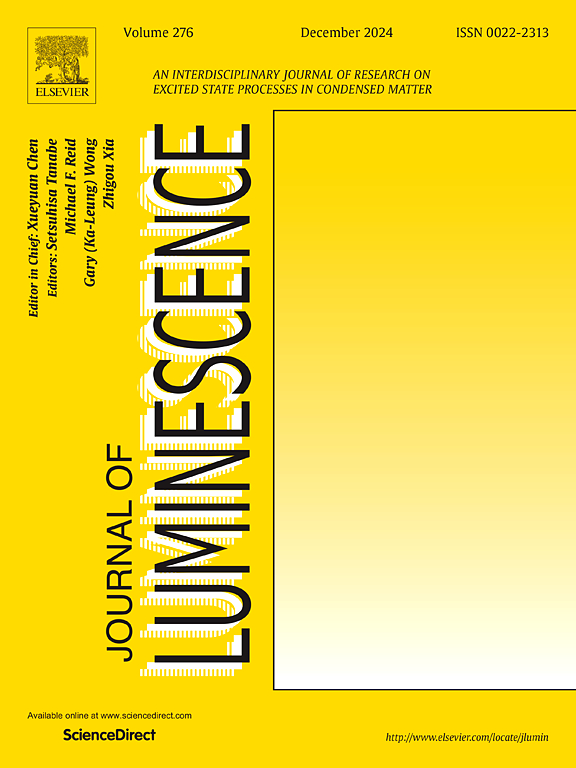Red-emitting LiAlSiO4:Eu3+ nanophosphors: A versatile material for lighting, forensic and anti-counterfeiting technologies
IF 3.3
3区 物理与天体物理
Q2 OPTICS
引用次数: 0
Abstract
High-performance red-emitting LiAlSiO4:Eu3+ (0–11 mol%) nanophosphors (LASO:Eu3+ NPs) are successfully synthesized via an eco-friendly, low-temperature solution combustion method, employing mushroom extract as a green fuel for the first time. These NPs are developed for applications in white light-emitting diodes (w-LEDs) and latent fingerprints (LFPs) visualization. Under 393 nm excitation (7F0 → 5L6 transition), LASO:Eu3+ NPs exhibit a prominent emission peak at 616 nm, corresponding to the 5D0 → 7F2 transition. The optimal doping concentration is determined to be 7 mol%, with concentration quenching primarily influenced by neighbouring ion interactions. The Commission Internationale de l’Éclairage (CIE) chromaticity coordinates of LASO:7Eu3+ NPs are determined to be (0.616, 0.377), with a color purity (CP) of 98.3 % and an average correlated color temperature (CCT) of 1832 K. Furthermore, the phosphors are evaluated for temperature-sensing capabilities based on the fluorescence intensity ratio (FIR) technique. The phosphor retains ∼86.10 % PL intensity at 423 K and exhibits internal quantum yield (IQE) of 65.20 %. Relative sensitivity is assessed using two different peak ratios, yielding maximum values at 303 K of 0.45 % K−1 for I537/I592 and 1.04 % K−1 for I537/I616. The suitability of the phosphor for the powder dusting method in fingerprints (FPs) detection on various surfaces is also assessed. Under 365 nm UV light, the LASO:7Eu3+ NPs clearly reveals the level I–III features of LFPs. A new anti-counterfeiting (AC) material utilizing LASO:7Eu3+ phosphor has been developed, showcasing intense red luminescence under UV light and offering distinctive optical features for secure and dependable authentication in advanced security systems. Overall, LASO:7Eu3+ NPs showing excellent red emission, thermal stability, and quantum efficiency. Their multifunctionality makes them promising candidates for w-LEDs, optical thermometry, and high-resolution LFPs detection.

发光LiAlSiO4:Eu3+纳米荧光粉:用于照明、法医和防伪技术的多功能材料
本文首次以香菇提取物为绿色燃料,采用环保的低温溶液燃烧方法成功合成了高性能红色发光LiAlSiO4:Eu3+ (0-11 mol%)纳米荧光粉(LASO:Eu3+ NPs)。这些NPs是为白光发光二极管(w- led)和潜在指纹(lfp)可视化应用而开发的。在393 nm激发下(7F0→5L6跃迁),LASO:Eu3+ NPs在616 nm处有一个突出的发射峰,对应于5D0→7F2跃迁。确定最佳掺杂浓度为7mol %,浓度猝灭主要受邻近离子相互作用的影响。LASO:7Eu3+ NPs的色度坐标(CIE)为(0.616,0.377),色纯度(CP)为98.3%,平均相关色温(CCT)为1832 K。此外,基于荧光强度比(FIR)技术对荧光粉的温度传感能力进行了评估。该荧光粉在423 K时保持约86.10%的PL强度,显示出65.20%的内量子产率(IQE)。使用两种不同的峰比评估相对灵敏度,在303 K下I537/I592的峰值为0.45% K−1,I537/I616的峰值为1.04% K−1。评价了荧光粉粉末法在不同表面指纹检测中的适用性。在365 nm紫外光下,LASO:7Eu3+ NPs清晰地显示出lfp的I-III级特征。一种利用LASO:7Eu3+荧光粉的新型防伪(AC)材料已经开发出来,在紫外光下显示出强烈的红色发光,并提供独特的光学特性,在先进的安全系统中提供安全可靠的认证。总的来说,LASO:7Eu3+ NPs表现出优异的红发射、热稳定性和量子效率。它们的多功能性使其成为w- led,光学测温和高分辨率lfp检测的有希望的候选者。
本文章由计算机程序翻译,如有差异,请以英文原文为准。
求助全文
约1分钟内获得全文
求助全文
来源期刊

Journal of Luminescence
物理-光学
CiteScore
6.70
自引率
13.90%
发文量
850
审稿时长
3.8 months
期刊介绍:
The purpose of the Journal of Luminescence is to provide a means of communication between scientists in different disciplines who share a common interest in the electronic excited states of molecular, ionic and covalent systems, whether crystalline, amorphous, or liquid.
We invite original papers and reviews on such subjects as: exciton and polariton dynamics, dynamics of localized excited states, energy and charge transport in ordered and disordered systems, radiative and non-radiative recombination, relaxation processes, vibronic interactions in electronic excited states, photochemistry in condensed systems, excited state resonance, double resonance, spin dynamics, selective excitation spectroscopy, hole burning, coherent processes in excited states, (e.g. coherent optical transients, photon echoes, transient gratings), multiphoton processes, optical bistability, photochromism, and new techniques for the study of excited states. This list is not intended to be exhaustive. Papers in the traditional areas of optical spectroscopy (absorption, MCD, luminescence, Raman scattering) are welcome. Papers on applications (phosphors, scintillators, electro- and cathodo-luminescence, radiography, bioimaging, solar energy, energy conversion, etc.) are also welcome if they present results of scientific, rather than only technological interest. However, papers containing purely theoretical results, not related to phenomena in the excited states, as well as papers using luminescence spectroscopy to perform routine analytical chemistry or biochemistry procedures, are outside the scope of the journal. Some exceptions will be possible at the discretion of the editors.
 求助内容:
求助内容: 应助结果提醒方式:
应助结果提醒方式:


